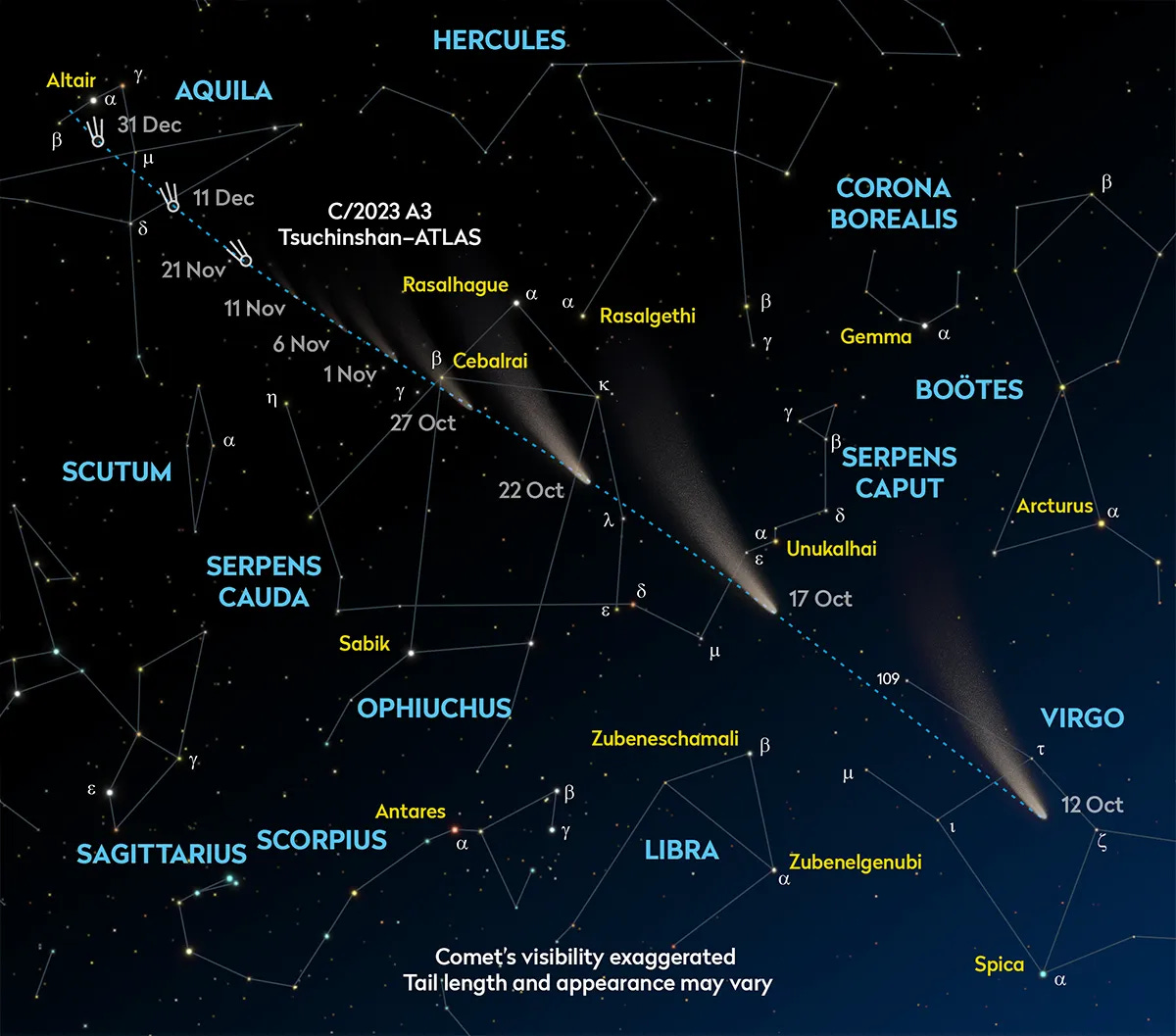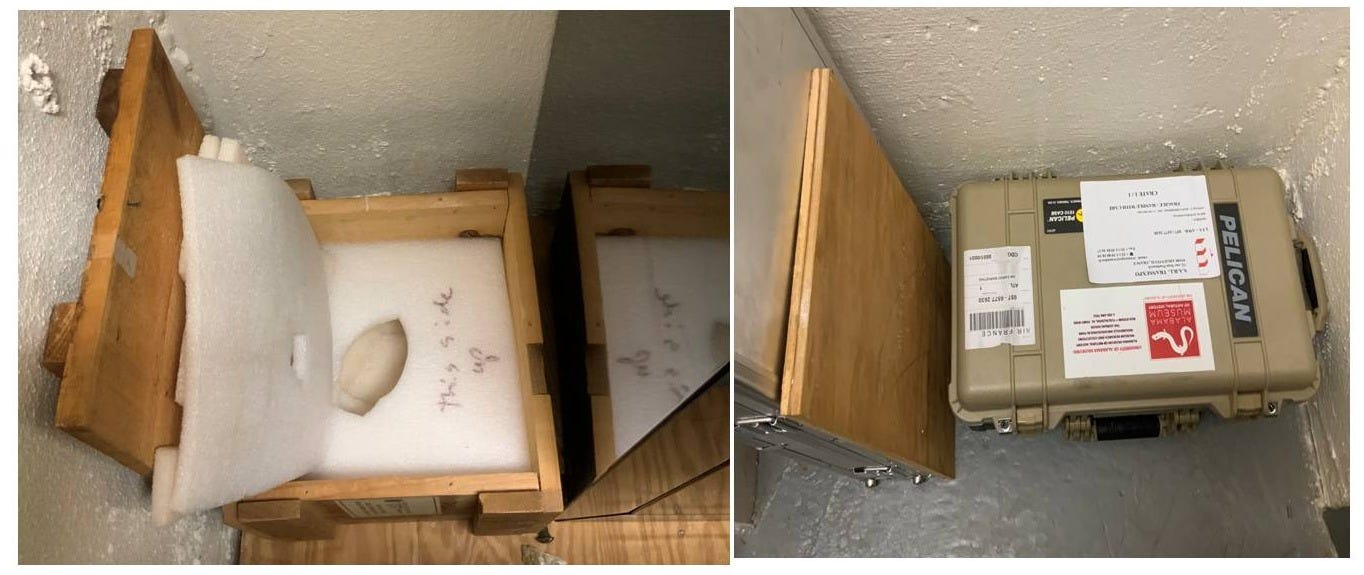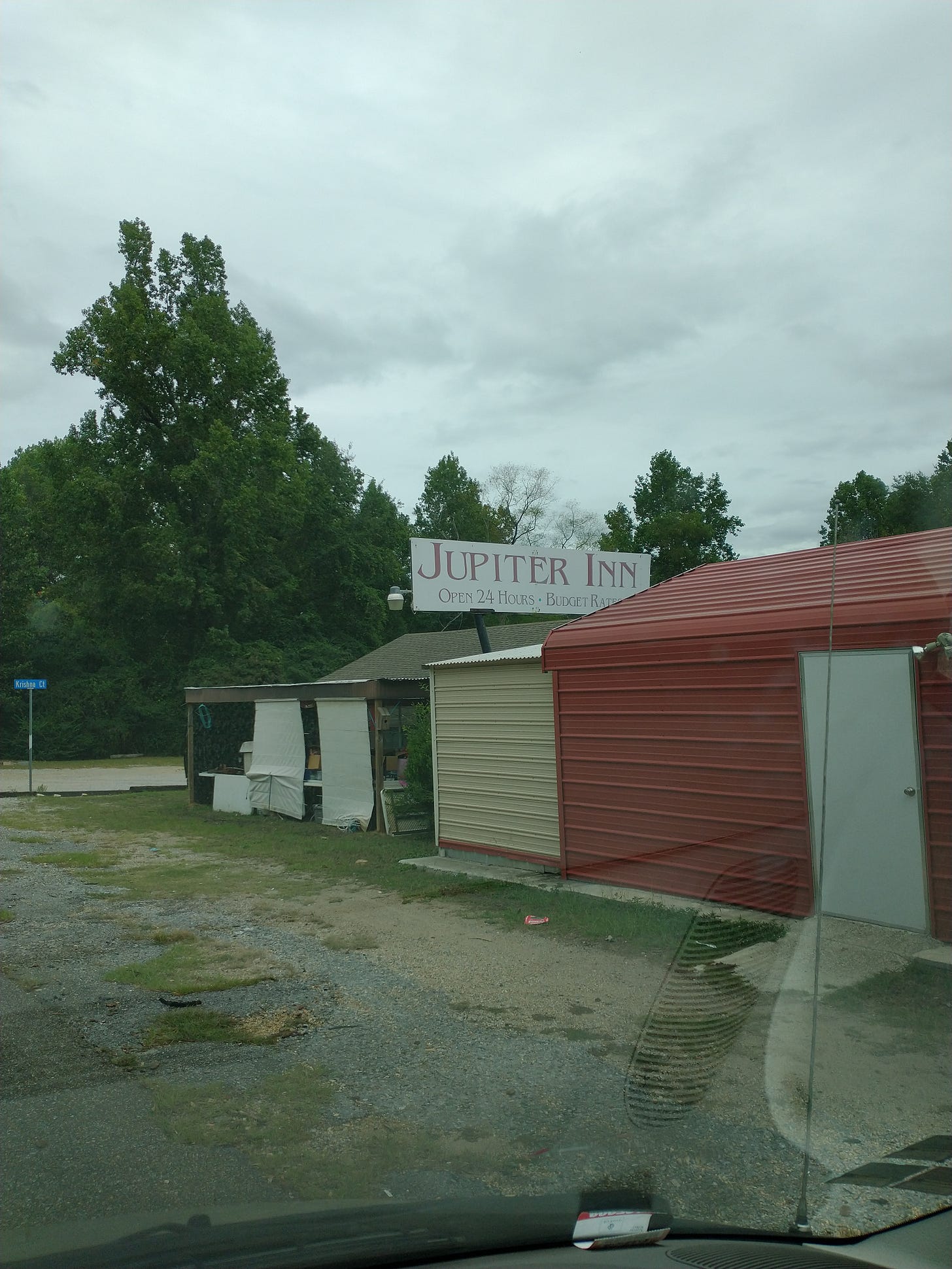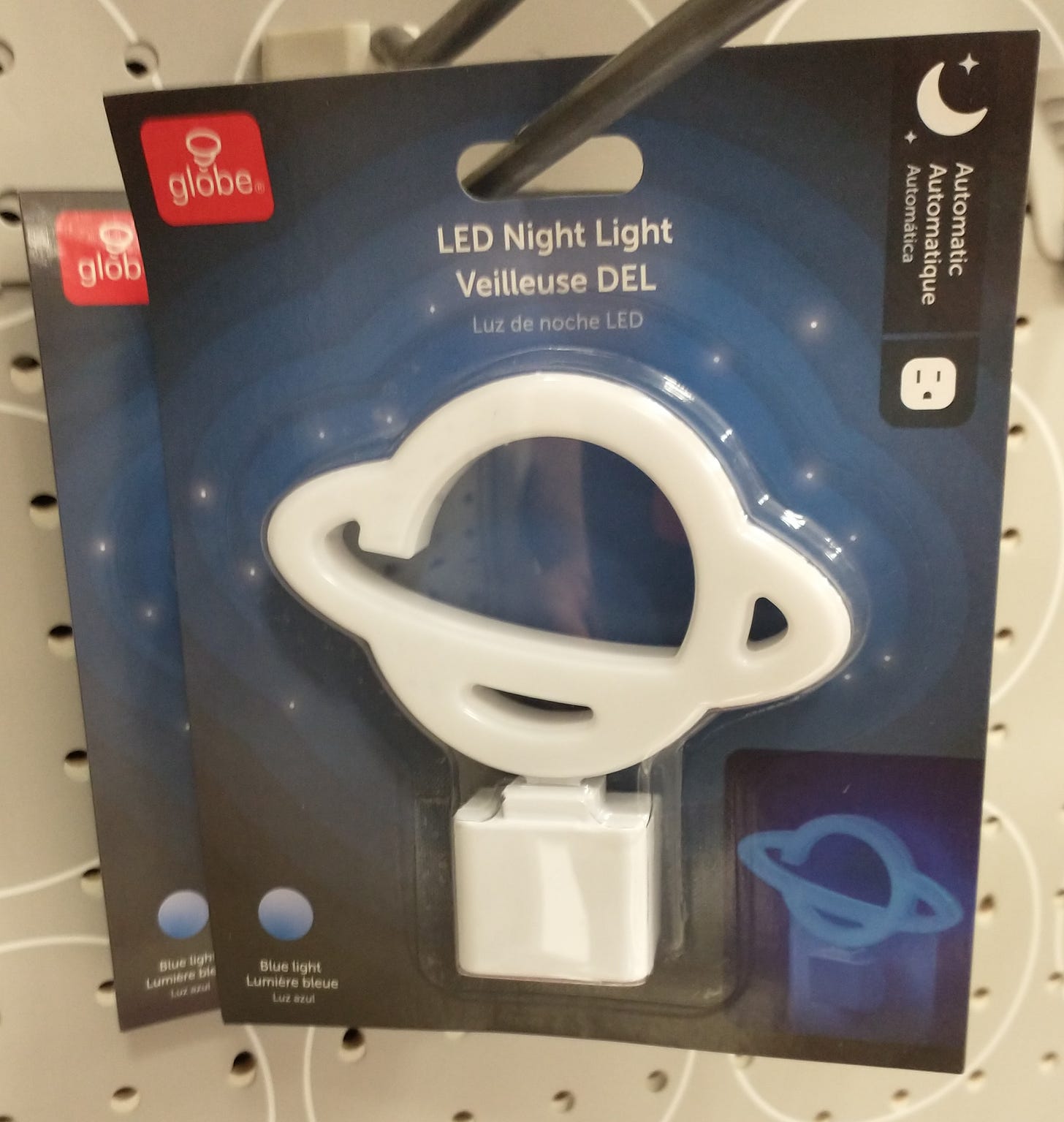#24R- The Hodges Meteorite - October Eclipses (or Nearly) - Giant Planets 'on' Earth - Comet A3
TGT 10/1/24: Handling A Million Dollar Rock From Space; Naked Eye Comet and Four Planets in the Evenings; Jupiter and Saturn on Earth; An Eclipse Good for Travel, An Eclipse You Have to Imagine.
Cover Photo - The Injurious Culprit

In This Issue:
Cover Photo — The Injurious Culprit
Welcome to Issue 24R!
Sky Planning Calendar —
* Moon-Gazing - The Moon Eclipses the Sun, and Other Objects* Observing—Plan-et - The Evening is Filling Up with Planets
* Comet and Eclipse to See, Oh My! - An Annular Eclipse and Comet A3
* For the Future - Almost Doesn’t Usually Count - An Intellectual Challenge, the Almost Eclipse
* Border Crossings - Total DisagreementAstronomical Travel - 70th Anniversary of a Meteorite Bruising, Part 2—THE Rock ‘n Radio
Astronomy in Everyday Life - Giant Planets in Alabama
Welcome to The Galactic Times Newsletter-Inbox Magazine #24R!
In the last issue we traveled to the small town of Sylacauga, AL, to see what is there from the event 70 years ago when a rock from space crashed through a house roof and into a woman, the only known case documented in modern recorded history. In this Issue we examine the only two surviving relics of that event, the rock itself and the radio it hit before it hit the woman, who survived.
Before you get to that article, though, we will tell you about the sky of early October. The evening sky has four of the five evening stars (but number 5 will join soon). There is an annular solar eclipse but it is a Polynesian and South American show. Partial phases will be visible in Hawaii and a few other interesting places worthy of an excuse for an holiday. We have a possibly naked eye comet entering the evening near the end of our fortnight and into the next one afterwards.
And finally, yours truly’s Alabama adventure to the see the Hodges meteorite had an additional bonus: spotted two things referencing Giant Planets, for the Astronomy in Everyday Life column.
Enjoy!
Publisher — Dr. Larry Krumenaker Email: newsletter@thegalactictimes.com
PS: Starting with the next issue, we plan that TGT will be sent out to PAID Subscribers 1-2 days in advance. It will be sent to everybody else on the Issue date. Subscribe! It is slightly over $1 per issue! lk
Sky Planning Calendar
Moon-Gazing
Moon passages by a star, planet or deep sky object are a good way to find a planet or other object if you’ve never located it before.
October 2 New Moon and Apogee….and an annular (ring) solar eclipse. See below.
October 5 Venus is about 3 degrees North of the evening twilight Moon, i.e. Venus is to the Moon’s upper right.
October 7 The summer star Antares is occulted by the Moon for people in Polynesia and Southern South America. For the rest of us, the Moon passes very close to the star, but in North America the Moon has moved several degrees East already by the time evening arrives.
October 10 First Quarter Moon
October 14 Saturn is the bright ‘star’ near the Moon. It is covered by Luna if you are in Africa or Asia.
October 16 Perigee, just a day before Full Moon. That will make this Full Moon the largest of the year. A true (if there was actually such a thing) Super Moon.
Observing---Plan-et
==Four Prominent Evening Planets==
Mercury is on leave this fortnight. It is entering the evening twilight but not yet far enough from the Sun to be easily found.
Venus, on the other hand, is now entering into full glory. It sets after evening twilight ends starting on the 14th and gains time every day through the end of the year, low but brilliant.
Mars reaches quadrature, 90-degrees from the Sun, on the 9th but by then it already rises before midnight (Daylight Saving Time).
Jupiter is entering into decent viewing, becoming stationary and beginning its retrograde motion moving in reverse (East to West) among the zodiacal stars. It rises two hours after evening twilight ends on the 1st, 90 minutes by the 15th.
Saturn is the main course in early evening and most of the night. Because it is past opposition (180-degrees from the Sun), telescopes can now see the planet’s shadow on its rings, at least a little bit. Already up when it gets dark, it sets less than 90 minutes before morning twilight begins.
Comet and Eclipse To See, Oh My!
Comet Tsuchinshan-ATLAS/2023 A3 or simply Comet A3 for short, was discovered last year at two separate observatories and was bright enough in September to be seen with the naked eye in the dawn, mainly for Southern Hemisphere observers. However, it reaches perihelion on October 14th, its nearest point to the Sun and by coincidence to the Earth as well, and enters into the evening twilight skies of the Northern Hemisphere. In fact, it may be at its brightest the 13-14th, low in the twilight but visible as a ‘star’ of 2nd to 4th magnitude (as bright at max is the Big Dipper stars to its upper right), though not star-like but fuzzy, with a tail. Recent reports at this writing indicate it is brighter than predicted and has two tails. It may appear as a slim V-shaped fan in the sky.
The comet will fade rapidly but still be small scope- and binocular-bright as it gets into the darker, non-twilit sky. Not the comet of the century, as some media extol it, and certainly not as bright as the magnificent comets of the 1990s, but neat to try to find, see, and photograph.
The best chance, though late, would be around October 28th when the then-dimmer comet is close to the second brightest star in Ophiuchus, Beta and near the prominent 4-star Bull of Poniatowski asterism to its lower left.
The Annular Eclipse of October 2
Because the Moon is at apogee a few hours earlier, this Moon isn’t large enough to cover the whole Sun at one time. So when it passes in front of ol’ Sol, there will be no corona or much other solar eclipse phenomena, certainly not a ‘twilight’-level dark sky. A ring of sunlight will still surround the Moon’s disk and without protective eye-gear you should not look at the Sun directly even during this eclipse.
Much of the eclipse will be visible only if you are on a cruise ship onsite in the Moon’s ‘shadow’ zone (probably too late to book a cruise now….). The only land areas that will be in the path of annularity will be Rapa Nui (Easter Island), and very southern Chile and Argentina.
Partial eclipse phases in the United States can be seen only in Hawaii. Elsewhere, they can be seen on one part of the extreme SW Mexican coastline (very minute coverage). In South America it is partial in parts of Peru, Paraguay, Uruguay, Bolivia and Brazil (an astronomical reason to visit Rio, well, just barely a partial eclipse there). Certain islands in the Atlantic, the Falklands and South Georgia, will have partial phases, and so will much of Antarctica. Bon voyage…..
For the Future
Almost Doesn’t Usually Count, But….
Last Full Moon we had a barely-in-the-umbra partial Lunar Eclipse. THIS coming full Moon, on the 17th, the day of our next Galactic Times issue, we have an ALMOST Lunar Eclipse. You won’t see a thing, eclipse-wise. The Moon *just* misses the outer shadow, the penumbra by just a few minutes of arc (60 of those per degree). What would be the interesting challenge, intellectually, is to try to imagine the shadow in the sky. It will be to the south or below the Full Moon, but a Moon diameter away (to reach its umbral edge) and more than two Moon diameters in size. Can you envision that?
To make a shadow visible you have to have a sunlit object go into it. This Full Moon almost does…… At the time of ‘Almost’, the Moon will be visible in North and Central America and East Asia only.
Border Crossings
The reality and the unreality don’t mix this month. The Sun spends this entire fortnight in Virgo. You have to read the Libra column in the horoscopes. Too bad….
Astronomical Travel
70th Anniversary of a Meteorite Bruising, Part 2
Have you ever handled a million dollar object? Yours truly did, and that rare event, as rare as what that object did, is discussed in this Part 2.
In the last Galactic Times issue, the story of the only meteorite to ever hit a person in modern recorded history (and that the woman hit survived), was told. Briefly, to review, on November 30, 1954, a meteor came to Earth, exploding loudly and visible over several Alabama counties, and split into three parts. It fell to Earth in the environs of the town of Sylacauga. One piece ended up spooking a horse, one was never found, but one fragment became famous for it hit a Mrs. Ann Hodges. The woman, not feeling well that early afternoon, lay down for a nap in a corner room of the rented house she shared with her husband. Her resting (she had not fallen asleep yet) was rudely interrupted when the meteor broke through the house roof, the room ceiling, bounced off a large console radio and hit her, lightly on the hand and not so lightly on her left thigh, making a deep and long bruise that has become well known worldwide among meteorite history buffs and even the general public nation and worldwide.
In the previous issue, TGT explored the people, places, and things of the event. The people are no longer with us. Mrs. Hodges is buried far off north of Huntsville. The sites are no longer as they were. The house burned down and a trailer is there. The aptly named Comet Drive-In movie theater, across the street, is now a subdivision in part, and a recycling center site. Two other businesses using the name Comet are now nearby. The horse-scaring fragment site is now a forested.
The event is memorialized in three places. There is an historical marker to the NE on the more major road in the area (the house was on an intersecting side road). In the front lawn of Sylacauga’s city hall is a marble sculpture of a falling meteor hitting Earth (marble was the previous main fame for the town). And the local historical museum, the Comer Museum and Arts Center, has displays showing original articles from papers and magazines, photographs and an encased for display replica of the Hodges fragment.
Those are the status’ of the people and places of the event from 70 years ago. What about the things? That’s the story to be shown today.
The Hodges Fragment
With the house gone, the only realia that matter are her couch, the radio, and the rock itself. The first’s whereabouts, even its existence years later, is totally unknown. But the radio and the meteorite still do exist, and both are under lock and key in a storage vault, rarely to be let out and seen in public, at the Alabama Museum of Natural History (AMNH) on the campus of the University of Alabama in Tuscaloosa. Because of its history, it is valued at $1,000,000 and thus is never un-escorted if it goes out at all.
But for the purposes of this article, the Museum kindly let this author get personal with Mrs. Hodges’ rock from space.
I was escorted to the storage vault, where other valuable rocks and items are stored. Those include rare gems, radioactive bones and other rocks. After opening the vault door I was let in and came face to face first with….
…. the infamous radio.
It was dusty from storage and surprisingly has no insured value. The spot where it was hit is clearly evident on top, and on its dial. From the vacuum tube era of electronics, it is unknown if it would still receive signals, and it has a very dusty turntable inside it.
Also in the vault was the original storage box it came in when given to the Museum for a small compensation that ended the lawsuit between the Hodges and their landlord. The meteorite is now kept in a much more secure, wheeled lockbox, which was brought into the Museum’s main exhibit hall.
On display there are mostly static exhibits, including several dinosaur skeletons, some other meteorites and various rocks, and exhibits on exploring natural sciences. The museum collections director wheeled the lockbox next to the display of the Sylacauga event.
Normally, it rarely is handled, by anyone, in this museum or elsewhere. But it was taken out of its case and, it was handed over to yours truly, wearing latex gloves. (See Cover Photo). It is dark, 8 pounds 6 ounces, with only two minor subtractions. Once, a small core hole was drilled into it, which could also be not only for analysis but for placement on the spindle in the exhibit hall display, and secondly, a tiny set of disks for use in analysis, too. If it wasn’t for what it did, this would just be a somewhat larger than average chondrite (stony) meteorite. These come from long-ago collisions in the asteroid belt, mainly.
Here, like in the Comer Museum, is a very realistic replica on display. Handling both you can see they are in appearance virtually identical, but the replica weighs less, though still hefty. Unlike in Comer there are only a small amount of text and two photographs to learn about the event. Comer’s display has a lot more copies of magazine and newspaper articles and photographs, but for researchers there are several large file boxes in storage that contain more, and original, magazines and clippings, plus legal documents on the rock and Mrs. Hodges, letters written to her by children, a copy of her appearance on television, and lots more.
At this time the AMNH has no plans to celebrate the event nor let the Hodges Fragment travel out of the building. An hour after we had intimate contact, it was snuggled back in its lockbox and storage vault.
What Other Sites To See?
That second piece, recovered 3.7 km/about 2 miles due north of the house near Zubers Road, spooked a horse making it easy to find on the land farmed by a Mr. McKinney. The therefore-named-McKinney Fragment resides in the National Museum of Natural History, part of the Smithsonian Museum in DC, and, you guessed it, in storage. The Smithsonian was queried as to its status—it is a little over two pounds—and a slice of it is on display in the Geology, Gems and Minerals Hall, 2nd floor. The main mass is in the research collection, not on display.
No other pieces have ever been found.
The 70th anniversary of the fall will be celebrated two days after this year’s Thanksgiving. According to Judy Green, director of the Comer Museum….
"The Comer Museum will be celebrating the 70 year anniversary of the Hodges meteorite on November 30. This event will start at 10 o’clock and end at 2 o’clock. We will have videos playing about the event. At 12:59 we will explain how an 8 1/2 pound meteorite felt when it landed on Mrs. Hodges. The visitors will have a chance to hold an 8 1/2 pound rock and imagine it falling through a roof and making Mrs. Hodges the only person hit by a meteorite and lived. At 1:05 on November 30 we will have a reenactment of an interview with Mrs. Hodges. We will hear her thoughts on exactly how it felt to have a meteorite hit her.”
Sylacauga doesn’t have much science beyond the tiny bit in the Comer Museum. If you do various searches in Google you’ll come up with three things: 1) Gravity Hill, a street of the same name where cars allegedly facing downhill go backwards uphill—apparently my car knows better than to break the law of gravity; 2) an area called The Moon at the end of a street called Comet Lane, nowhere near the fall site, but it is just a wooded area, the street becoming someone’s driveway; and 3) a few miles north in Childersburg there is a tour-able underground cavern, but it is more touristy and even a bit of religion thrown into the show, and little science.
—LK
The author gratefully thanks the following persons for their assistance:
Judy Comer, Director, The Comer Museum and Arts Center
Brooke Bogan, Natural History Collections Manager, University of Alabama Museum of Natural History, Tuscaloosa, AL
Tad Bennicoff, Tim McCoy and Cori Corrigan, Smithsonian Institution
Dr. Ronald J. Buta, emeritus professor, Astronomy, University of Alabama, and a dear long-time ago former classmate of the author who helped arrange for the museum visit.
Astronomy in Everyday Life
Giant Planets in Alabama
Found these two connected items while driving to and from Tuscaloosa, Alabama, while doing the Astronomical Travel story.
On the way up I almost screeched to a sudden halt—fortunately nobody was behind me—in surprise. This is the only site line I could get that day.
Yes, it is a hotel, but not these buildings. The rooms are behind this scene. On the Web I found a better shot (but no photographer credit)….
Reviews were mixed, some extolling the management and site, others describing it as a real dump. Cheap but no place for a holiday. Apparently several people are there more or less permanently, renting rooms as if an apartment.
Given the description of some of the furnishings, this device I found at a Target store, might be both helpful and appropriate to the theme……
Enjoying The Galactic Times? Please help support it by subscribing, and consider a paid Subscription. Hit the button below and choose. Wisely…..
Till next issue,
Dr. Larry Krumenaker











